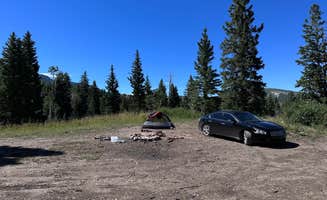Tent camping near Cleveland, Utah provides access to both desert landscapes and high-elevation forest environments across central Utah. The region transitions from sagebrush flats to pinyon-juniper woodlands, with elevations ranging from 4,500 to 8,000 feet. Winter snowfall can make many dispersed camping areas inaccessible from November through April, while summer temperatures at lower elevations regularly exceed 90°F.
What to do
Explore desert ravines and canyons: The Trio Ravine Overlook area offers hiking opportunities through unique desert terrain. Camper Lauren S. notes, "Very windy in March but breathtaking night skies and beautiful sunrise."
Mountain biking on adjacent trails: Campsites along Willow Creek Road provide direct access to mountain biking routes. Daniel S. mentions, "It is RIGHT next to a mountain bike trail, so expect some early-morning bikers to be coming down."
Wildlife observation: Search for wild burros in the lower desert areas. Some locations offer opportunities for bird watching, particularly at dawn when desert species are most active.
Stargazing without equipment: The minimal light pollution provides exceptional night sky viewing opportunities. The new moon phase offers optimal viewing conditions with celestial objects visible to the naked eye.
What campers like
Cooler temperatures at higher elevations: The higher sites along Willow Creek Road provide relief from summer heat. Tracey W. shares, "You are at almost 8000 ft so not a winter camping spot. There is some ATV traffic but respectfully slow."
Solitude during weekdays: Most dispersed areas see minimal traffic Monday through Thursday. According to Dalton, "Was there on a thursday and saw 2 other people. Campsite I stayed at/the drive up is amazing during sunset."
Established fire rings at select sites: Some dispersed camping areas feature previously used fire pits, though availability varies by location. Always check current fire restrictions as they change seasonally based on conditions.
Desert sunrises and sunsets: The open terrain allows for unobstructed views of colorful skies at dawn and dusk. Many campers position tents to maximize morning light and minimize afternoon heat exposure.
What you should know
High clearance vehicle requirements: Many dispersed sites require navigating challenging terrain. Cameron G. from San Rafael Dispersed Camping advises, "You will need 4x4 as there is a bunch of really sandy spots and some pretty gnarly dips so high clearance would be nice."
Limited or no cell service: Most camping areas lack reliable connectivity. Prepare navigation and emergency plans accordingly. Download offline maps before departure.
Gate management: Some access roads require opening and closing gates. Logan notes, "You have to open a gate to get through, didn't quite go to this exact spot but it was quiet on the dirt road and a lot of pull offs."
Water requirements: No potable water exists at dispersed sites. Plan for 1-2 gallons per person per day during summer months, plus additional emergency reserves.
No trash services: All waste must be packed out. Consider bringing garbage bags specifically for collecting trash from previous campers to help maintain the area.
Tips for camping with families
Scout for established sites: Look for areas with natural boundaries and space between camping spots. The most suitable family locations typically have flat ground for multiple tents.
Morning shade considerations: Select sites with western tree cover to block early morning sun. This helps prevent tents from becoming uncomfortably hot shortly after sunrise.
Wildlife awareness: Teach children about desert wildlife safety, particularly regarding snakes and scorpions. Shake out shoes and bedding regularly as precaution.
Temperature preparation: Bellevue Flats TH and similar locations experience significant day-night temperature swings. Pack layers for children, as nighttime temperatures can drop below 50°F even in summer months.
Low-impact activities: Bring binoculars, identification guides, and journals for nature observation without disturbing surroundings. The sparse vegetation makes wildlife easier to spot than in dense forest settings.
Tips from RVers
Length restrictions: Most dispersed sites accommodate smaller RVs under 25 feet. Larger rigs should research specific access points in advance.
Level parking challenges: Bring extra leveling blocks as many sites feature uneven terrain. The desert landscape often has hidden dips and slopes not immediately visible.
Limited turnaround space: Scout potential sites before committing, as many roads lack adequate room to turn larger vehicles. Consider unhitching towed vehicles at main roads before exploring side routes.
Dust protection: Keep windows sealed during windy conditions. Fine desert dust penetrates even small openings and can damage sensitive electronics and breathing passages.



